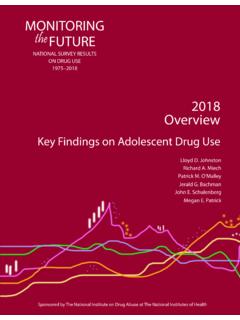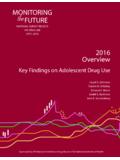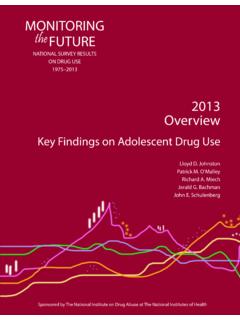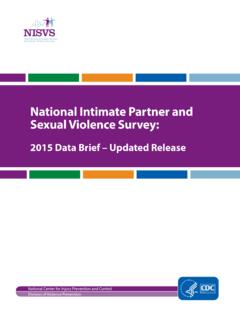Transcription of MONITORING FUTURE the
1 MONITORING FUTURENATIONAL survey RESULTS ON drug USE1975 20212021 OverviewtheSponsored by The national Institute on drug Abuse at The national Institutes of HealthKey Findings on Adolescent drug Use Lloyd D. Johnston Richard A. Miech Patrick M. O Malley Jerald G. Bachman John E. Schulenberg Megan E. Patrick MONITORING THE FUTURE national survey RESULTS ON drug USE, 1975 20212021 OverviewKey Findings on Adolescent drug Use Lloyd D. Johnston, Richard A. Miech, Patrick M. O Malley, Jerald G. Bachman, John E. Schulenberg, Megan E. Patrick, Institute for Social Research The University of Michigan Sponsored by national Institute on drug Abuse The national Institutes of Health Published January 2022 This publication was written by the principal investigators and staff of the MONITORING the FUTURE project at the Institute for Social Research, the University of Michigan, under Research Grant R01 DA 001411 from the national Institute on drug Abuse.
2 The findings and conclusions in this report are those of the authors and do not necessarily represent the views of the sponsor. Public Domain Notice All material appearing in this volume is in the public domain and may be reproduced or copied, whether in print or non-print media including derivatives, in any reasonable manner, without permission from the authors. To modify the material, please contact the MONITORING the FUTURE Project at for verification of accuracy. Citation of the source is appreciated, including at least the following: MONITORING the FUTURE , Institute for Social Research, University of Michigan. Recommended Citation Johnston, L. D., Miech, R. A., O Malley, P. M., Bachman, J.
3 G., Schulenberg, J. E., & Patrick, M. E.(2022). MONITORING the FUTURE national surveyresults on drug use 1975-2021: Overview, keyfindings on adolescent drug use. Ann Arbor:Institute for Social Research, University of for Social Research The University of Michigan Ann Arbor, Michigan Printed January 2022 Contents Click on any item below (in blue) to go directly to that page. Summary of Key Findings ..1 Introduction ..6 Study Design and Methods ..9 Specific Results by drug Any Illicit drug ..13 Marijuana ..16 Synthetic Marijuana ..19 Inhalants ..21 LSD ..24 Cocaine ..27 Crack ..30 Amphetamines and Other Stimulant Drugs ..33 Methamphetamine and Crystal Methamphetamine (Ice) ..36 Heroin ..38 Other Narcotic Drugs, Including OxyContin and Vicodin.
4 41 Tranquilizers ..44 Sedatives (Barbiturates) ..46 MDMA (Ecstasy, Molly) and Other Club Drugs ..49 Alcohol ..52 Cigarettes ..55 Smokeless Tobacco ..58 Vaping ..61 Other Tobacco Products ..64 Steroids ..66 Subgroup Differences ..70 Lessons Learned ..71 Page 1 Tables in Lifetime Prevalence of Use of Various Drugs forGrades 8, 10, and 12 Combined ..73 in Annual Prevalence of Use of Various Drugs forGrades 8, 10, and 12 Combined ..76 in 30 Day Prevalence of Use of Various Drugs forGrades 8, 10, and 12 Combined ..79 in Daily Prevalence of Use of Selected Drugs and HeavyUse of Alcohol and Tobacco for Grades 8, 10, and 12 Combined ..82 in Lifetime Prevalence of Use of Various Drugs inGrades 8, 10, and 12 ..84 in Annual Prevalence of Use of Various Drugs inGrades 8, 10, and 12 ..92 in 30 day Prevalence of Use of Various Drugs inGrades 8, 10, and 12.
5 102 in 30 Day Prevalence of Daily Use of Various Drugs inGrades 8, 10, and 12 ..110 in Two Week Prevalence of Extreme Binge Drinking inGrades 8, 10, & 12 ..113 in Harmfulness of Drugs as Perceived by 8th Graders ..118 in Harmfulness of Drugs as Perceived by 10th Graders ..123 in Harmfulness of Drugs as Perceived by 12th Graders ..128 in Disapproval of drug Use in Grade 8 ..135 in Disapproval of drug Use in Grade 10 ..138 in Disapproval of drug Use in Grade 12 ..141 in Availability of Drugs as Perceived by 8th Graders ..145 in Availability of Drugs as Perceived by 10th Graders ..148 in Availability of Drugs as Perceived by 12th Graders ..151 Page 2 Summary of Key Findings MONITORING the FUTURE (MTF) is a long term study of substance use and related factors among adolescents, college students, and adult high school graduates through age 60.
6 It is conducted annually and supported by the national Institute on drug Abuse. MTF findings identify emerging substance use problems, track substance use trends, are published with many scientific results, and help to inform policy and intervention strategies. It has been tracking adolescent drug use on nationally representative samples since 1975. The key findings regarding use of various substances by 8th, 10th, and 12th graders surveyed across the in 2021 are summarized below. But first a few words about the context. The preceding year, 2020, was an unusual year for the study in that data collection was halted earlier than usual, in March of that year, due to the emerging COVID-19 epidemic and the University of Michigan halting in-person research. This resulted in smaller samples being obtained that year, but based on careful analyses we believe that the smaller samples reflect drug use for all students that year with reasonable accuracy (more on this is presented in the section on Study Design and Methods).
7 The previous year, 2019, was unusual in a different way it was the year that the study was transitioning from using paper and pencil questionnaires in schools to having students use electronic tablets. A random half of all respondents in 2019 used the older mode of administration, while the other half used tablets. How we dealt with these two disruptions to the ongoing series will be described in the section on Study Design and Methods. It should be noted that the 2020 data collection occurred early in 2020, covering the early months of the epidemic, but it did not cover most of the period of the epidemic that year, nor of its effects. However, the 2021 data collection occurred more than a year into the COVID epidemic and brought quite dramatic changes in adolescent drug use in the United States, as will be summarized in this analyses and associated tables and figures that follow present trends in the use of most of the substances we track for all three grades separately and combined, as well as trends in key attitudes (disapproval of use), beliefs (perceived risk of use), and perceived availability.
8 An additional set of tables provides trends in drug use for the three grades combined (Tables 1 4). This information gives a summary of the general nature of historical trends over a number of years, though it obscures any age or cohort effects that may be occurring. This Summary section draws on the samples containing data from the three grades combined, with an emphasis on the unusual developments between 2020 and 2021. For simultaneous trends that are in the same direction and general magnitude across all three grades, these combined analyses provide greater statistical power to detect the extent to which historical period effects are occurring. To the extent that changes are duplicated but lagged by two years from one grade level to the next, we have considerable evidence of a cohort effect. In a number of cases we provide insight into the age, period, and cohort effects that underlie trends in use, as well as in key attitudes and beliefs.
9 MTF is designed to detect these effects, which can indicate what may be driving certain changes. Age effects are changes that occur as people get older and show up in a similar way across most or all cohorts as they pass through a particular period in development; they are common during adolescence. Period effects are changes that are parallel over some years across multiple age groups (in this case, all three grades under study 8, 10, and 12). Cohort effects are consistent differences among birth cohorts (or in this case, class cohorts in secondary school), differences that are then maintained as the cohorts age. Page 1A Broad and Deep Decline in drug Use in 2021 As a scan across the figures in this monograph will show. will show, most forms of drug use showed steep and atypical declines in 2021.
10 Those declines can be summarized by glancing ahead to Figure 1 on page 15 where two indexes that we use to provide a summary of overall changes are shown. It may be seen there that the proportion of students who say that they used any illicit drug in their lifetime or in the last 12 months dropped sharply in all three grades in 2021. For the three grades combined, lifetime prevalence of using any illicit drug declined by percentage points and annual prevalence declined by percentage points in 2021, both significant at the p<.001 level. They amount to relative declines from the prevalence levels in 2020 of 22% and 27% in just one year. The comparable declines for using any illicit drug other than marijuana were and percentage points. (They amount to relative declines from the previous year of 22% and 29%.)












